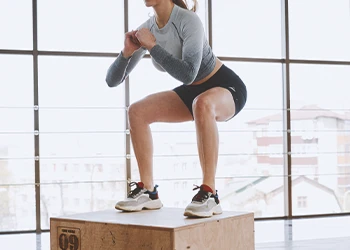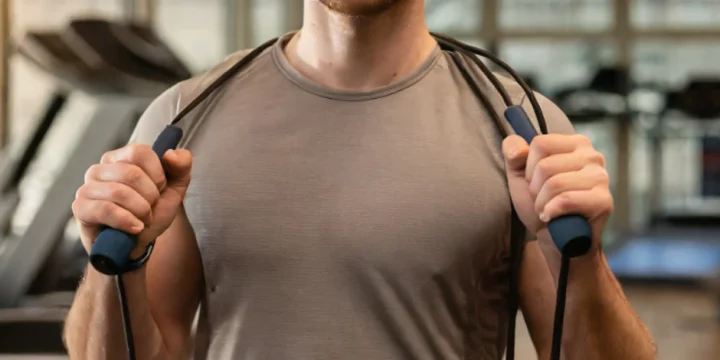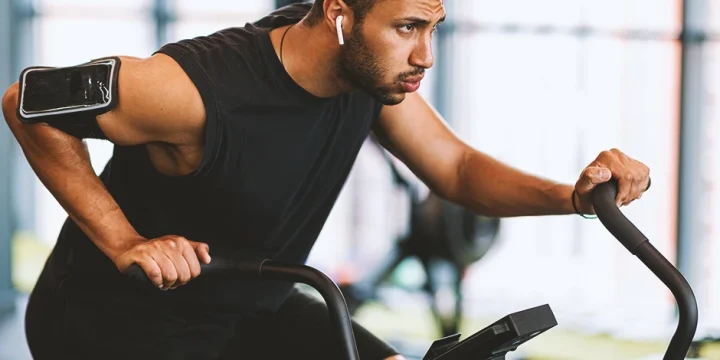A Plyo box is one of the best pieces of equipment for performing box jumps, increasing your vertical leap explosive strength, and improving the joint structure.
Based on my experience as a certified personal trainer and more than 23 hours of research, I singled out the most relevant benefits of box jumps and the best exercises you can perform to develop muscle explosiveness and boost the resilience of your joints.
After reading the article, you will know how to perform these exercises with proper form, maximized performance, and without injury.
Quick Summary
- Box jumps enhance vertical leap, explosive strength, and joint health, making them a valuable addition to fitness routines.
- To perform a box jump properly, you must enter a quarter squat position with your feet shoulder-width apart and quickly launch yourself from the ground on the lower box.
- A study in the National Library of Medicine highlights the risk of overtraining with high-intensity box jumps, underscoring the importance of balanced training.
- Personally, I find box jumps to be an effective and enjoyable way to improve overall athletic performance and cardiovascular health.
Benefits of Plyometric Box Jumps

To maximize plyometric box jumps and their benefits, you must avoid overtraining and doing high-intensity and maximal jumps daily.
According to a study in the National Library of Medicine, this will force your body to enter an overtraining state or syndrome that will hinder your performance and increase the chance of potential injury [1].
Below are listed the most important benefits of plyometric box jumps.
"More power means an enhanced ability to lift more weight more quickly, and, over time, that’ll translate to more weight on the barbell. Building power requires the right exercises, and the box jump is one of the best moves to build (and test) your lower-body power output."
- Mike Dewar, Certified Personal Trainer
Get the Right Amount of Joint Impact
In my years of training, I've seen how box jumps can initially be challenging for the ankle, knee, and hip joints. But with consistent practice, these joints adapt and learn to effectively absorb the impact.
All three joints must learn how to properly amortize the movement so your joints and muscles never get injured.
You will drastically improve your joint health by doing a regular box jump over some time.
However, if you want to see even bigger benefits from these plyometric jumps, ensure variety and incorporate more challenging box jumps, such as depth jumps and unilateral jump variations.
Boost Your Explosiveness

From my experience, plyometric jumps like box jumps are game-changers for increasing explosive strength.
This is crucial for maximal athletic performance and sports requiring fast, controlled, and explosive movements on the field.
Usually, the best way to increase your vertical jump, running speed, or anything similar is to use the complex training method [2].
The complex training method pairs submaximal lifting exercises, such as back squats, with plyometric training exercises, such as box or depth jumps.
According to a PubMed study, the higher the box, the more explosive strength you will build, but only to a certain point [3].
Challenge Hip Extension and Flexion
In my training, focusing on hip flexion and extension during box jumps has noticeably improved my stability and agility, especially in dynamic sports movements.
This is beneficial as all types of jumps require fast flexion and extension movements.
For example, when you jump, you must explosively bend your hips forward and then, with even greater explosiveness, extend your hips so you can help energy flow from ankles and knees to the upper body into your hands.
This is assuming you are using the optimal jumping technique for maximal vertical height.
Hip flexion and extension strength are crucial as those two are responsible for trunk and overall body stability in the sagittal plane, allowing for proper lumbar spine position and less chance of injury.
Related Articles:
Spark Cardio Conditioning

Through regular box jumps, I've seen a marked improvement in my cardio endurance, making it a staple in my high-intensity workouts.
You will develop resilience to the particular jumping exercise when you perform box jumps long enough.
Jumping is a whole-body activity, mainly using your leg and hip muscles to produce movement.
You will improve your cardio and lower body conditioning significantly when you perform jumps repetitively over a longer period.
Benefits of Box Jumps for Older Age Groups
I've successfully incorporated modified box jumps for my older clients, and witnessed firsthand their improvements in balance and muscle strength.
These are health and fitness advantages for older adults of box jumps.
Enhancing Bone Health and Postural Stability
As we age, maintaining bone health and postural stability becomes crucial. Box jumps, a form of plyometric exercise, can be instrumental in this regard.
For seniors, low-intensity box jumps can help in strengthening bones, thereby reducing the risk of osteoporosis. This exercise also enhances balance and coordination, which are vital for preventing falls, a common concern in older age.
Improving Physical Performance and Muscle Strength
Regular engagement in modified box jumps can lead to improvements in overall physical performance and muscle strength for seniors.
These exercises aid in maintaining muscle mass and improving functional strength, which is essential for daily activities.
The dynamic nature of box jumps also ensures that multiple muscle groups are engaged, promoting full-body fitness.
How to Do a Box Jump
Here is how to perform a box jump correctly:
- Place the box in front of you.
- Assume a shoulder-width apart standing stance with your knees slightly bent and hands near your body.
- Explosively move your body by bending your ankles, knees, and hips and entering the quarter squat position.
- From there, quickly produce force and jump off the ground on the elevated surface (plyo box).
- Repeat for three to five reps, rest for 2-3 minutes, and repeat.
Increase Box Jump Benefits

Here are the best exercises to increase your box jump.
Step-up
Incorporating step-ups into my routine has significantly enhanced my box jump performance, particularly strengthening my lower body.
How to Perform Step-Ups
- Place a stepper or a smaller box in front of you.
- Assume a hip-width apart stance with your feet and pick two smaller dumbbells to perform up to 8 step-ups with both legs.
- Start the exercise by stepping on the box with your right leg and immediately extending the same leg so you end up standing on top of the box.
- Reverse the motion to return to the starting position and repeat with the same leg.
- Finish 8 reps with one leg first, then transition to work on the left leg.
Seated Box Jumps

Seated box jumps will only focus on the concentric portion of the jump and neglect the eccentric muscle phase.
How to Perform Seated Box Jumps
- Place one smaller box behind you and a larger box in front of you.
- Sit on the smaller box so your feet are firmly on the ground and your back is straight.
- Start the exercise by only performing the concentric portion of the jump - explosively extend your ankles, knees, and hips simultaneously.
- Jump on the higher box, hold the position where you end up for one second, and ensure you stabilize your body without falling off the box.
- Repeat for 3-5 reps, rest for a couple of minutes, and do 3-5 sets.
Depth Box Jumps
The Russian strength and conditioning scientist Yuri Verkhoshansky initially developed depth box jumps, also called the father of plyometrics.
How to Perform Depth Box Jumps
- Place the box of appropriate height in front of you.
- Step on the box with both your feet and assume standing feet hip-width apart stance.
- Drop off the box, land on the ground, and quickly produce the force to translate a depth jump into a high vertical leap.
- Do a couple of reps, rest for 3-5 minutes, and then repeat.
Incorporating Box Jumps into Different Workout Routines
Here's how to integrate box jumps into various workout routines:
- Strength training: Incorporating box jumps into a strength training routine can enhance explosive power and muscle activation. Performing box jumps at the beginning of a workout, after a warm-up, prepares the muscles and central nervous system for the intense lifting ahead.
- Boosting cardiovascular workouts: Box jumps increase heart rate and improve endurance. Integrating short bursts of box jumps between cardio exercises, like running or cycling, can create a high-intensity interval training (HIIT) effect, leading to better fat burn and improved cardiovascular health.
- For sports-specific training: For example, basketball and volleyball players can use box jumps to improve their vertical leap. Similarly, soccer and football players can enhance their explosive speed and agility by incorporating these exercises into their training regimen.
Related Article: Vertical Jump Exercises
FAQs
Is It Ok to Do Box Jumps Everyday?
It depends on your age, joint health status, and conditioning if doing box jumps every day is ok. If you have healthy joints, enough plyometric training experience, know the proper form for all jumping exercises, and have enough explosive power.
Do Box Jumps Burn Belly Fat?
Box jumps may burn belly fat in a non-direct way. It is impossible to choose the place where you want your fat stores to be used during exercise since local fat-burning is a popular fitness myth.
What Muscles Do Box Jumps Work?
Box jumps work muscles such as the quadriceps, glutes, hamstrings, hip flexors, soleus, gastrocnemius, and additional stabilizer muscles. Box jump benefits include vertical jump improvements and overall improvement in explosive strength for the previously mentioned muscles.
References:
- https://www.ncbi.nlm.nih.gov/pmc/articles/PMC3435910/
- https://www.ncbi.nlm.nih.gov/pmc/articles/PMC3963241/
- https://pubmed.ncbi.nlm.nih.gov/32187147/
About The Author
You May Also Like






